An Analysis of Kellogg's Organisational Structure and Culture
VerifiedAdded on 2020/11/23
|9
|2752
|53
Essay
AI Summary
This essay provides a comprehensive analysis of Kellogg's organizational structure and culture, examining how these factors influence the company's performance. It begins by defining organizational structure and culture, then delves into Kellogg's specific approach, including its geographic area division structure and formal organizational structure. The essay explores the interrelation between structure and culture, highlighting how Kellogg's culture, defined by its values and principles, impacts employee motivation and overall success. It discusses Schein's culture triangle, illustrating artifacts, espoused values, and underlying assumptions within Kellogg's. Furthermore, the essay examines leadership and management variables, such as time management and communication, and the significance of customer-centricity. It also explores the impact of the Hawthorne experiments on understanding employee behavior within the context of Kellogg's. The essay concludes by emphasizing the importance of a strong organizational culture for enhancing performance and achieving business objectives.
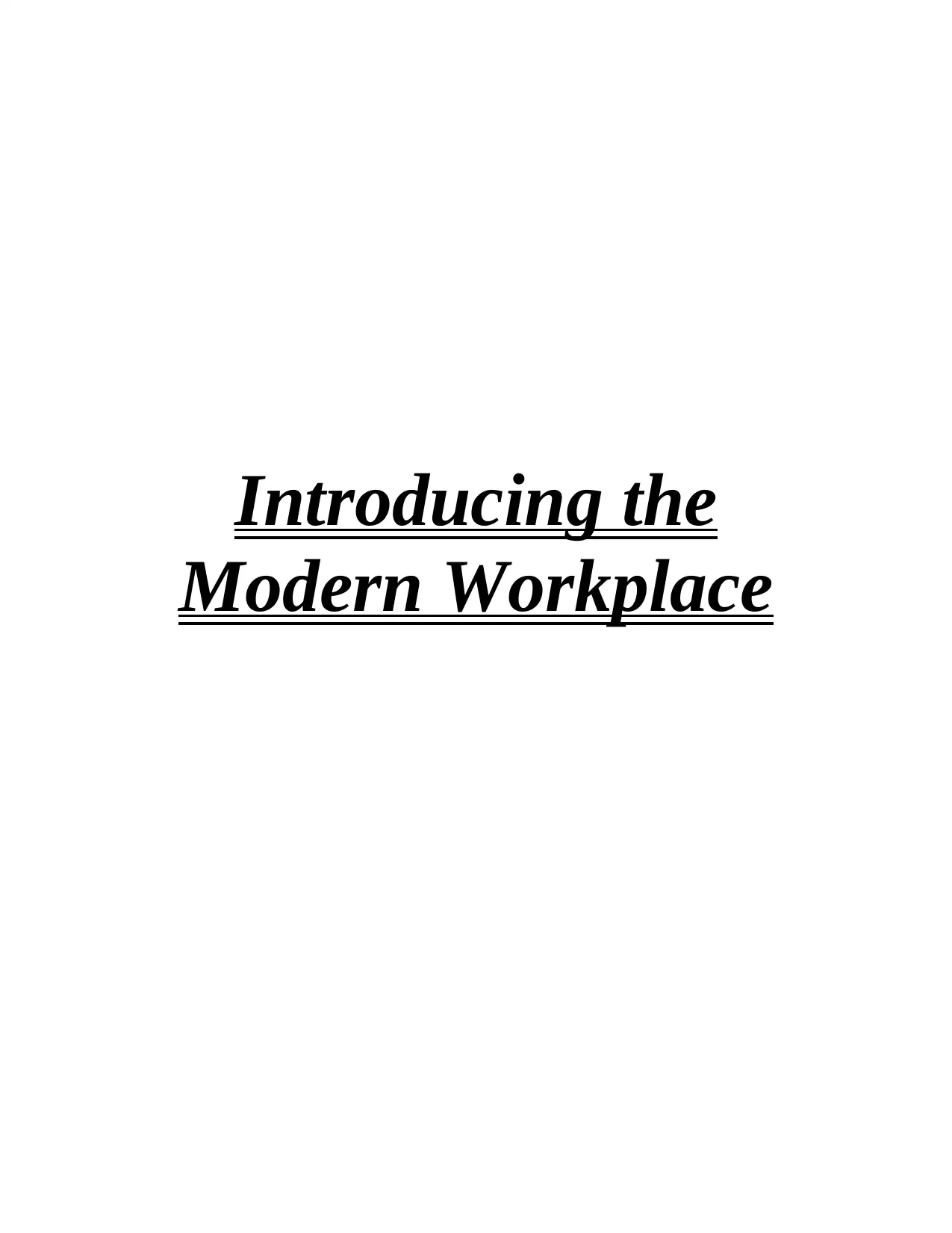
Introducing the
Modern Workplace
Modern Workplace
Paraphrase This Document
Need a fresh take? Get an instant paraphrase of this document with our AI Paraphraser
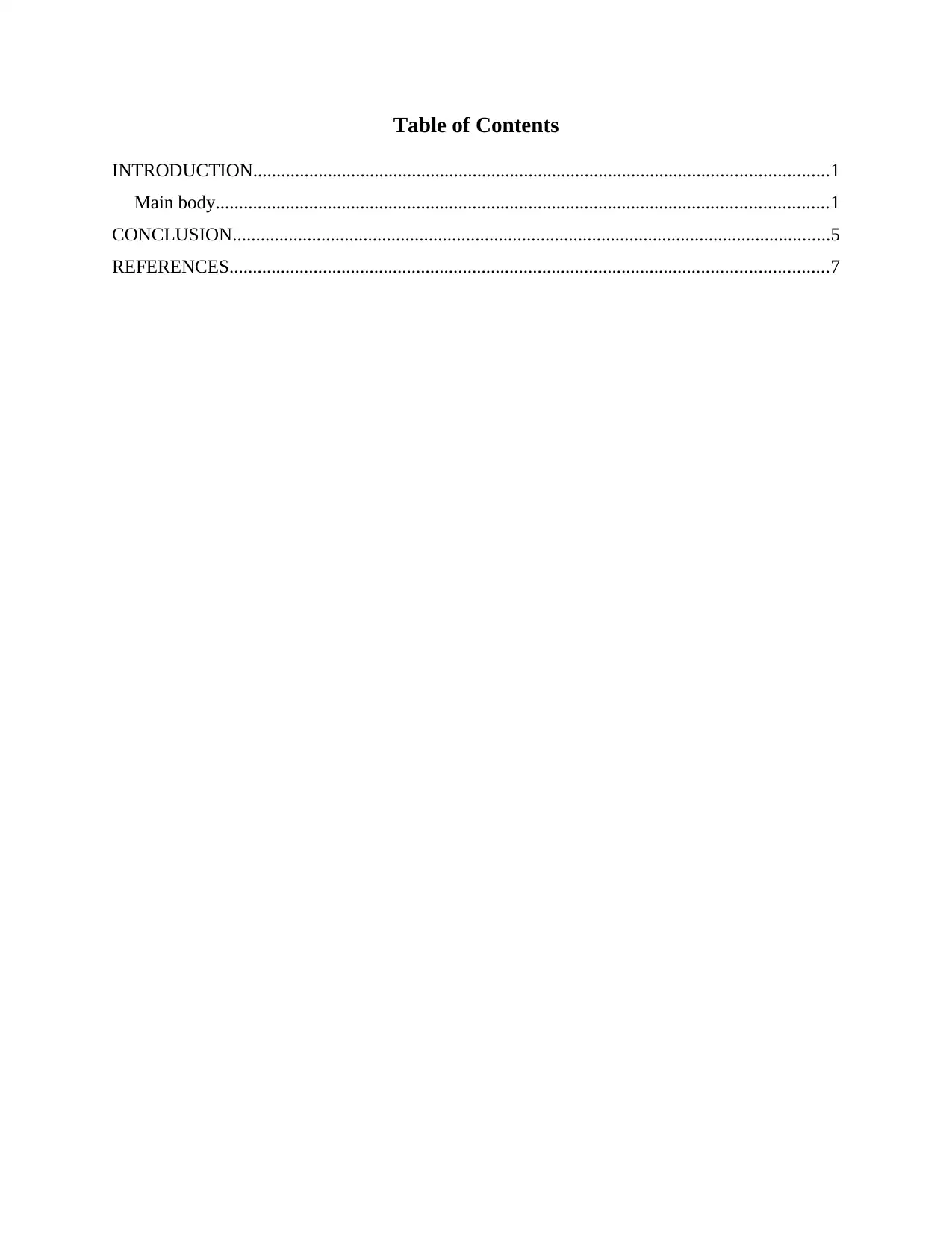
Table of Contents
INTRODUCTION...........................................................................................................................1
Main body...................................................................................................................................1
CONCLUSION................................................................................................................................5
REFERENCES................................................................................................................................7
INTRODUCTION...........................................................................................................................1
Main body...................................................................................................................................1
CONCLUSION................................................................................................................................5
REFERENCES................................................................................................................................7
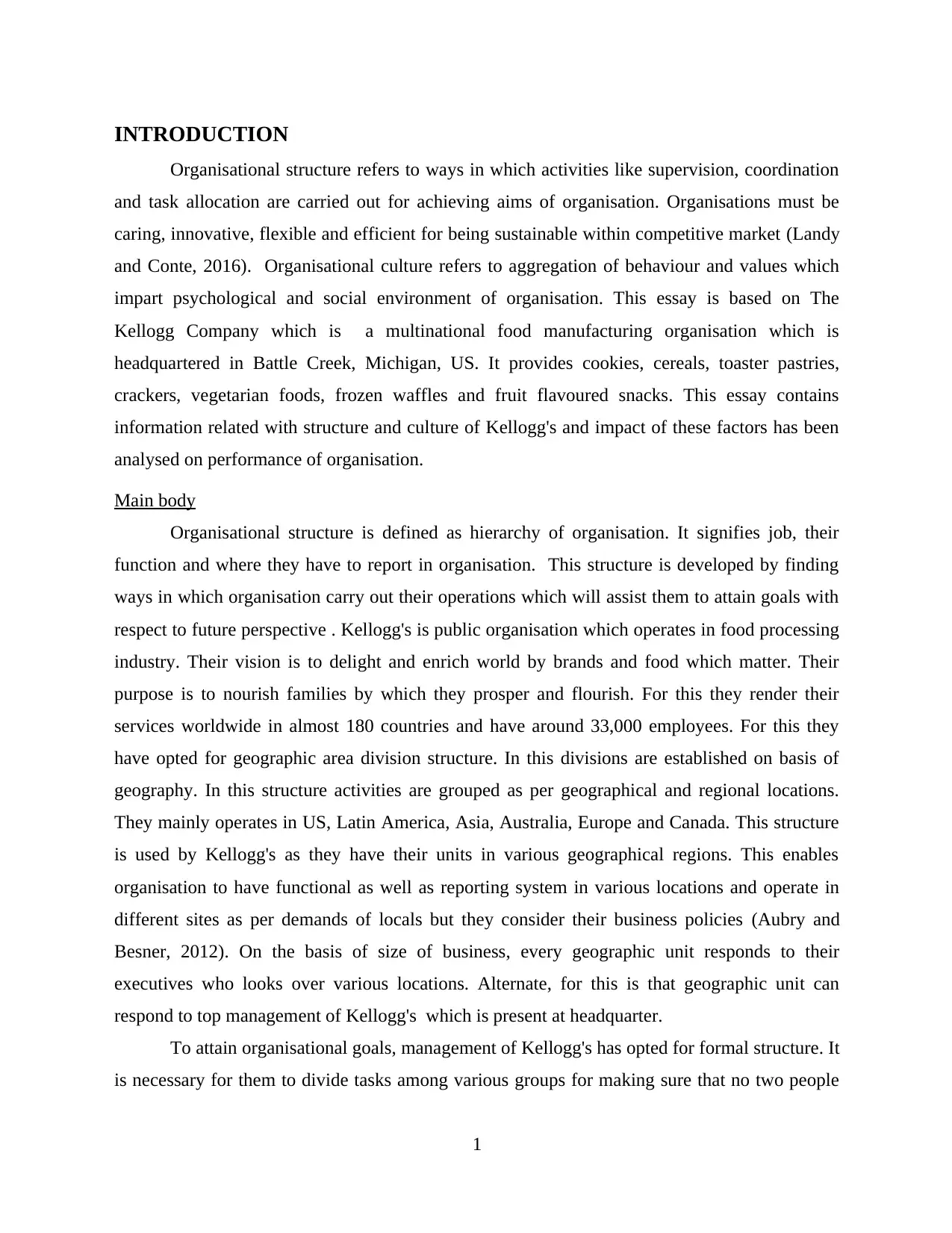
INTRODUCTION
Organisational structure refers to ways in which activities like supervision, coordination
and task allocation are carried out for achieving aims of organisation. Organisations must be
caring, innovative, flexible and efficient for being sustainable within competitive market (Landy
and Conte, 2016). Organisational culture refers to aggregation of behaviour and values which
impart psychological and social environment of organisation. This essay is based on The
Kellogg Company which is a multinational food manufacturing organisation which is
headquartered in Battle Creek, Michigan, US. It provides cookies, cereals, toaster pastries,
crackers, vegetarian foods, frozen waffles and fruit flavoured snacks. This essay contains
information related with structure and culture of Kellogg's and impact of these factors has been
analysed on performance of organisation.
Main body
Organisational structure is defined as hierarchy of organisation. It signifies job, their
function and where they have to report in organisation. This structure is developed by finding
ways in which organisation carry out their operations which will assist them to attain goals with
respect to future perspective . Kellogg's is public organisation which operates in food processing
industry. Their vision is to delight and enrich world by brands and food which matter. Their
purpose is to nourish families by which they prosper and flourish. For this they render their
services worldwide in almost 180 countries and have around 33,000 employees. For this they
have opted for geographic area division structure. In this divisions are established on basis of
geography. In this structure activities are grouped as per geographical and regional locations.
They mainly operates in US, Latin America, Asia, Australia, Europe and Canada. This structure
is used by Kellogg's as they have their units in various geographical regions. This enables
organisation to have functional as well as reporting system in various locations and operate in
different sites as per demands of locals but they consider their business policies (Aubry and
Besner, 2012). On the basis of size of business, every geographic unit responds to their
executives who looks over various locations. Alternate, for this is that geographic unit can
respond to top management of Kellogg's which is present at headquarter.
To attain organisational goals, management of Kellogg's has opted for formal structure. It
is necessary for them to divide tasks among various groups for making sure that no two people
1
Organisational structure refers to ways in which activities like supervision, coordination
and task allocation are carried out for achieving aims of organisation. Organisations must be
caring, innovative, flexible and efficient for being sustainable within competitive market (Landy
and Conte, 2016). Organisational culture refers to aggregation of behaviour and values which
impart psychological and social environment of organisation. This essay is based on The
Kellogg Company which is a multinational food manufacturing organisation which is
headquartered in Battle Creek, Michigan, US. It provides cookies, cereals, toaster pastries,
crackers, vegetarian foods, frozen waffles and fruit flavoured snacks. This essay contains
information related with structure and culture of Kellogg's and impact of these factors has been
analysed on performance of organisation.
Main body
Organisational structure is defined as hierarchy of organisation. It signifies job, their
function and where they have to report in organisation. This structure is developed by finding
ways in which organisation carry out their operations which will assist them to attain goals with
respect to future perspective . Kellogg's is public organisation which operates in food processing
industry. Their vision is to delight and enrich world by brands and food which matter. Their
purpose is to nourish families by which they prosper and flourish. For this they render their
services worldwide in almost 180 countries and have around 33,000 employees. For this they
have opted for geographic area division structure. In this divisions are established on basis of
geography. In this structure activities are grouped as per geographical and regional locations.
They mainly operates in US, Latin America, Asia, Australia, Europe and Canada. This structure
is used by Kellogg's as they have their units in various geographical regions. This enables
organisation to have functional as well as reporting system in various locations and operate in
different sites as per demands of locals but they consider their business policies (Aubry and
Besner, 2012). On the basis of size of business, every geographic unit responds to their
executives who looks over various locations. Alternate, for this is that geographic unit can
respond to top management of Kellogg's which is present at headquarter.
To attain organisational goals, management of Kellogg's has opted for formal structure. It
is necessary for them to divide tasks among various groups for making sure that no two people
1
⊘ This is a preview!⊘
Do you want full access?
Subscribe today to unlock all pages.

Trusted by 1+ million students worldwide
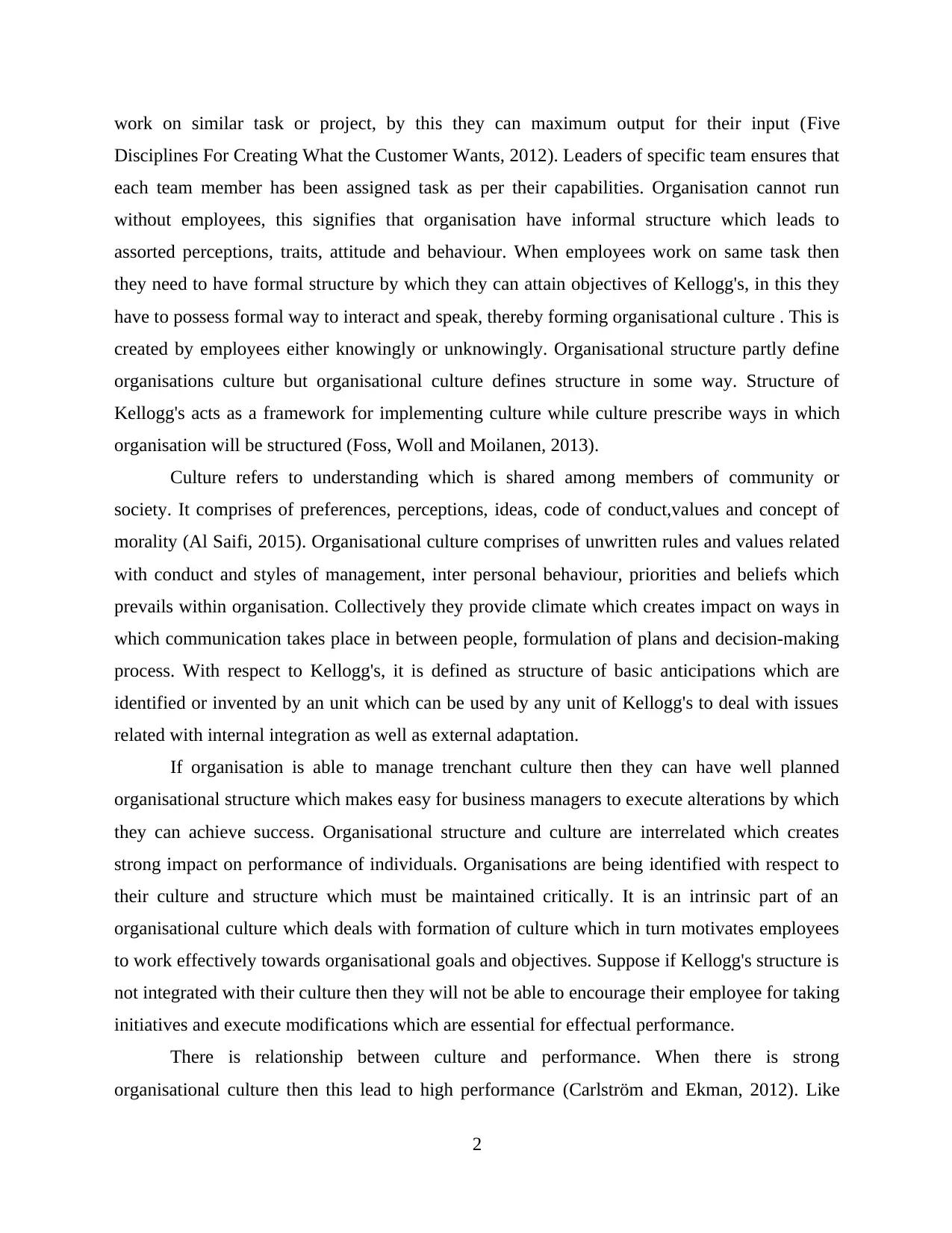
work on similar task or project, by this they can maximum output for their input (Five
Disciplines For Creating What the Customer Wants, 2012). Leaders of specific team ensures that
each team member has been assigned task as per their capabilities. Organisation cannot run
without employees, this signifies that organisation have informal structure which leads to
assorted perceptions, traits, attitude and behaviour. When employees work on same task then
they need to have formal structure by which they can attain objectives of Kellogg's, in this they
have to possess formal way to interact and speak, thereby forming organisational culture . This is
created by employees either knowingly or unknowingly. Organisational structure partly define
organisations culture but organisational culture defines structure in some way. Structure of
Kellogg's acts as a framework for implementing culture while culture prescribe ways in which
organisation will be structured (Foss, Woll and Moilanen, 2013).
Culture refers to understanding which is shared among members of community or
society. It comprises of preferences, perceptions, ideas, code of conduct,values and concept of
morality (Al Saifi, 2015). Organisational culture comprises of unwritten rules and values related
with conduct and styles of management, inter personal behaviour, priorities and beliefs which
prevails within organisation. Collectively they provide climate which creates impact on ways in
which communication takes place in between people, formulation of plans and decision-making
process. With respect to Kellogg's, it is defined as structure of basic anticipations which are
identified or invented by an unit which can be used by any unit of Kellogg's to deal with issues
related with internal integration as well as external adaptation.
If organisation is able to manage trenchant culture then they can have well planned
organisational structure which makes easy for business managers to execute alterations by which
they can achieve success. Organisational structure and culture are interrelated which creates
strong impact on performance of individuals. Organisations are being identified with respect to
their culture and structure which must be maintained critically. It is an intrinsic part of an
organisational culture which deals with formation of culture which in turn motivates employees
to work effectively towards organisational goals and objectives. Suppose if Kellogg's structure is
not integrated with their culture then they will not be able to encourage their employee for taking
initiatives and execute modifications which are essential for effectual performance.
There is relationship between culture and performance. When there is strong
organisational culture then this lead to high performance (Carlström and Ekman, 2012). Like
2
Disciplines For Creating What the Customer Wants, 2012). Leaders of specific team ensures that
each team member has been assigned task as per their capabilities. Organisation cannot run
without employees, this signifies that organisation have informal structure which leads to
assorted perceptions, traits, attitude and behaviour. When employees work on same task then
they need to have formal structure by which they can attain objectives of Kellogg's, in this they
have to possess formal way to interact and speak, thereby forming organisational culture . This is
created by employees either knowingly or unknowingly. Organisational structure partly define
organisations culture but organisational culture defines structure in some way. Structure of
Kellogg's acts as a framework for implementing culture while culture prescribe ways in which
organisation will be structured (Foss, Woll and Moilanen, 2013).
Culture refers to understanding which is shared among members of community or
society. It comprises of preferences, perceptions, ideas, code of conduct,values and concept of
morality (Al Saifi, 2015). Organisational culture comprises of unwritten rules and values related
with conduct and styles of management, inter personal behaviour, priorities and beliefs which
prevails within organisation. Collectively they provide climate which creates impact on ways in
which communication takes place in between people, formulation of plans and decision-making
process. With respect to Kellogg's, it is defined as structure of basic anticipations which are
identified or invented by an unit which can be used by any unit of Kellogg's to deal with issues
related with internal integration as well as external adaptation.
If organisation is able to manage trenchant culture then they can have well planned
organisational structure which makes easy for business managers to execute alterations by which
they can achieve success. Organisational structure and culture are interrelated which creates
strong impact on performance of individuals. Organisations are being identified with respect to
their culture and structure which must be maintained critically. It is an intrinsic part of an
organisational culture which deals with formation of culture which in turn motivates employees
to work effectively towards organisational goals and objectives. Suppose if Kellogg's structure is
not integrated with their culture then they will not be able to encourage their employee for taking
initiatives and execute modifications which are essential for effectual performance.
There is relationship between culture and performance. When there is strong
organisational culture then this lead to high performance (Carlström and Ekman, 2012). Like
2
Paraphrase This Document
Need a fresh take? Get an instant paraphrase of this document with our AI Paraphraser
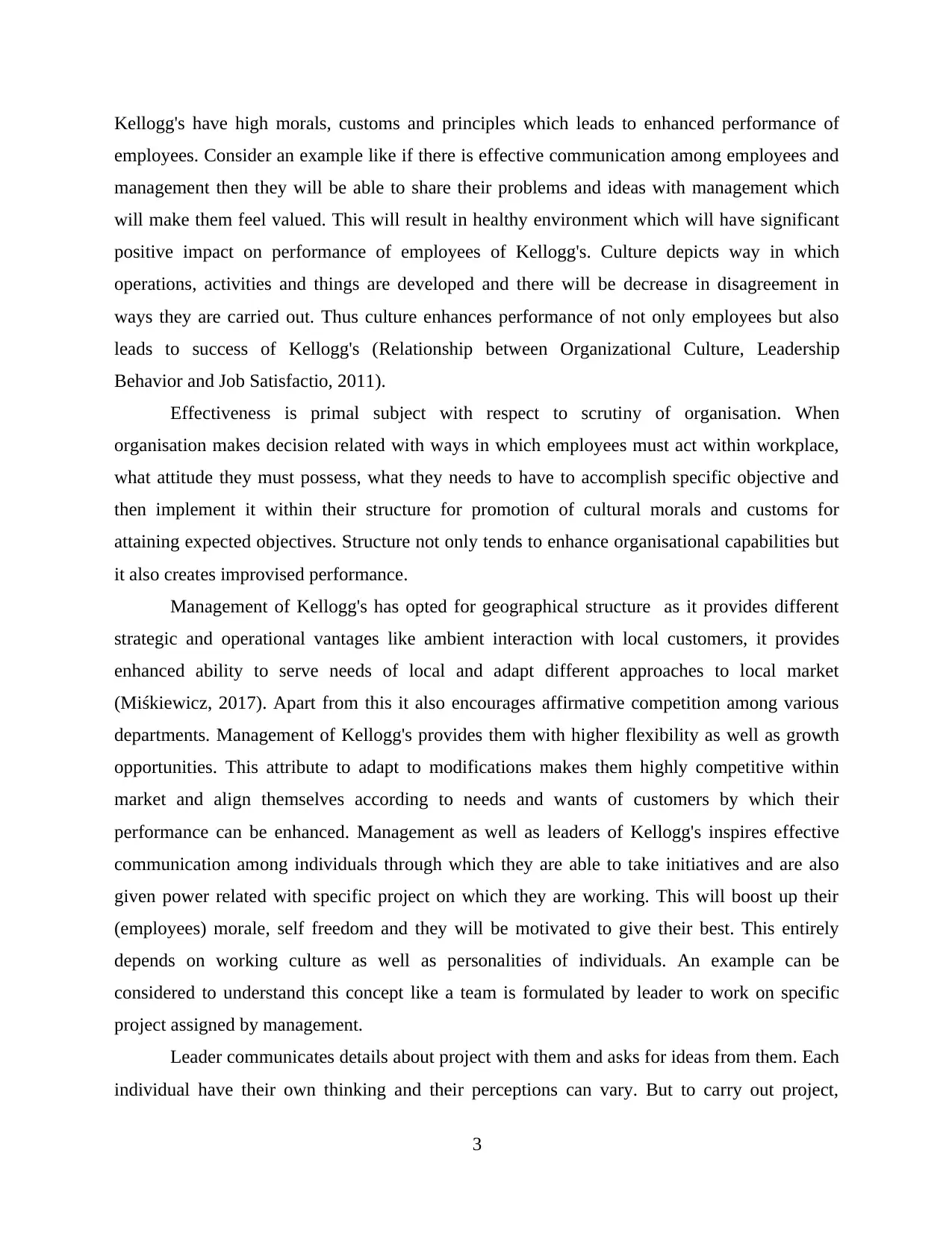
Kellogg's have high morals, customs and principles which leads to enhanced performance of
employees. Consider an example like if there is effective communication among employees and
management then they will be able to share their problems and ideas with management which
will make them feel valued. This will result in healthy environment which will have significant
positive impact on performance of employees of Kellogg's. Culture depicts way in which
operations, activities and things are developed and there will be decrease in disagreement in
ways they are carried out. Thus culture enhances performance of not only employees but also
leads to success of Kellogg's (Relationship between Organizational Culture, Leadership
Behavior and Job Satisfactio, 2011).
Effectiveness is primal subject with respect to scrutiny of organisation. When
organisation makes decision related with ways in which employees must act within workplace,
what attitude they must possess, what they needs to have to accomplish specific objective and
then implement it within their structure for promotion of cultural morals and customs for
attaining expected objectives. Structure not only tends to enhance organisational capabilities but
it also creates improvised performance.
Management of Kellogg's has opted for geographical structure as it provides different
strategic and operational vantages like ambient interaction with local customers, it provides
enhanced ability to serve needs of local and adapt different approaches to local market
(Miśkiewicz, 2017). Apart from this it also encourages affirmative competition among various
departments. Management of Kellogg's provides them with higher flexibility as well as growth
opportunities. This attribute to adapt to modifications makes them highly competitive within
market and align themselves according to needs and wants of customers by which their
performance can be enhanced. Management as well as leaders of Kellogg's inspires effective
communication among individuals through which they are able to take initiatives and are also
given power related with specific project on which they are working. This will boost up their
(employees) morale, self freedom and they will be motivated to give their best. This entirely
depends on working culture as well as personalities of individuals. An example can be
considered to understand this concept like a team is formulated by leader to work on specific
project assigned by management.
Leader communicates details about project with them and asks for ideas from them. Each
individual have their own thinking and their perceptions can vary. But to carry out project,
3
employees. Consider an example like if there is effective communication among employees and
management then they will be able to share their problems and ideas with management which
will make them feel valued. This will result in healthy environment which will have significant
positive impact on performance of employees of Kellogg's. Culture depicts way in which
operations, activities and things are developed and there will be decrease in disagreement in
ways they are carried out. Thus culture enhances performance of not only employees but also
leads to success of Kellogg's (Relationship between Organizational Culture, Leadership
Behavior and Job Satisfactio, 2011).
Effectiveness is primal subject with respect to scrutiny of organisation. When
organisation makes decision related with ways in which employees must act within workplace,
what attitude they must possess, what they needs to have to accomplish specific objective and
then implement it within their structure for promotion of cultural morals and customs for
attaining expected objectives. Structure not only tends to enhance organisational capabilities but
it also creates improvised performance.
Management of Kellogg's has opted for geographical structure as it provides different
strategic and operational vantages like ambient interaction with local customers, it provides
enhanced ability to serve needs of local and adapt different approaches to local market
(Miśkiewicz, 2017). Apart from this it also encourages affirmative competition among various
departments. Management of Kellogg's provides them with higher flexibility as well as growth
opportunities. This attribute to adapt to modifications makes them highly competitive within
market and align themselves according to needs and wants of customers by which their
performance can be enhanced. Management as well as leaders of Kellogg's inspires effective
communication among individuals through which they are able to take initiatives and are also
given power related with specific project on which they are working. This will boost up their
(employees) morale, self freedom and they will be motivated to give their best. This entirely
depends on working culture as well as personalities of individuals. An example can be
considered to understand this concept like a team is formulated by leader to work on specific
project assigned by management.
Leader communicates details about project with them and asks for ideas from them. Each
individual have their own thinking and their perceptions can vary. But to carry out project,
3
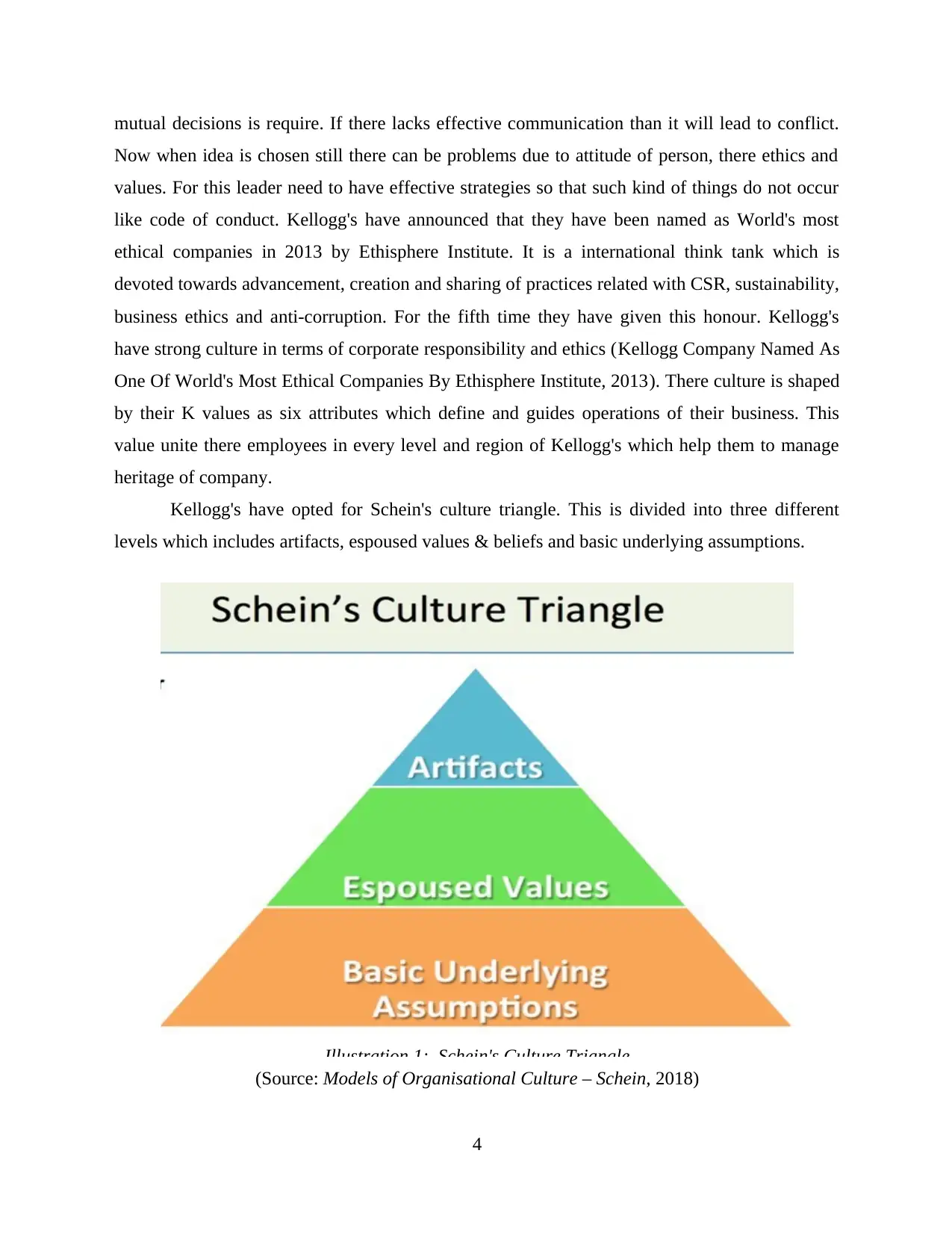
mutual decisions is require. If there lacks effective communication than it will lead to conflict.
Now when idea is chosen still there can be problems due to attitude of person, there ethics and
values. For this leader need to have effective strategies so that such kind of things do not occur
like code of conduct. Kellogg's have announced that they have been named as World's most
ethical companies in 2013 by Ethisphere Institute. It is a international think tank which is
devoted towards advancement, creation and sharing of practices related with CSR, sustainability,
business ethics and anti-corruption. For the fifth time they have given this honour. Kellogg's
have strong culture in terms of corporate responsibility and ethics (Kellogg Company Named As
One Of World's Most Ethical Companies By Ethisphere Institute, 2013). There culture is shaped
by their K values as six attributes which define and guides operations of their business. This
value unite there employees in every level and region of Kellogg's which help them to manage
heritage of company.
Kellogg's have opted for Schein's culture triangle. This is divided into three different
levels which includes artifacts, espoused values & beliefs and basic underlying assumptions.
(Source: Models of Organisational Culture – Schein, 2018)
4
Illustration 1: Schein's Culture Triangle
Now when idea is chosen still there can be problems due to attitude of person, there ethics and
values. For this leader need to have effective strategies so that such kind of things do not occur
like code of conduct. Kellogg's have announced that they have been named as World's most
ethical companies in 2013 by Ethisphere Institute. It is a international think tank which is
devoted towards advancement, creation and sharing of practices related with CSR, sustainability,
business ethics and anti-corruption. For the fifth time they have given this honour. Kellogg's
have strong culture in terms of corporate responsibility and ethics (Kellogg Company Named As
One Of World's Most Ethical Companies By Ethisphere Institute, 2013). There culture is shaped
by their K values as six attributes which define and guides operations of their business. This
value unite there employees in every level and region of Kellogg's which help them to manage
heritage of company.
Kellogg's have opted for Schein's culture triangle. This is divided into three different
levels which includes artifacts, espoused values & beliefs and basic underlying assumptions.
(Source: Models of Organisational Culture – Schein, 2018)
4
Illustration 1: Schein's Culture Triangle
⊘ This is a preview!⊘
Do you want full access?
Subscribe today to unlock all pages.

Trusted by 1+ million students worldwide
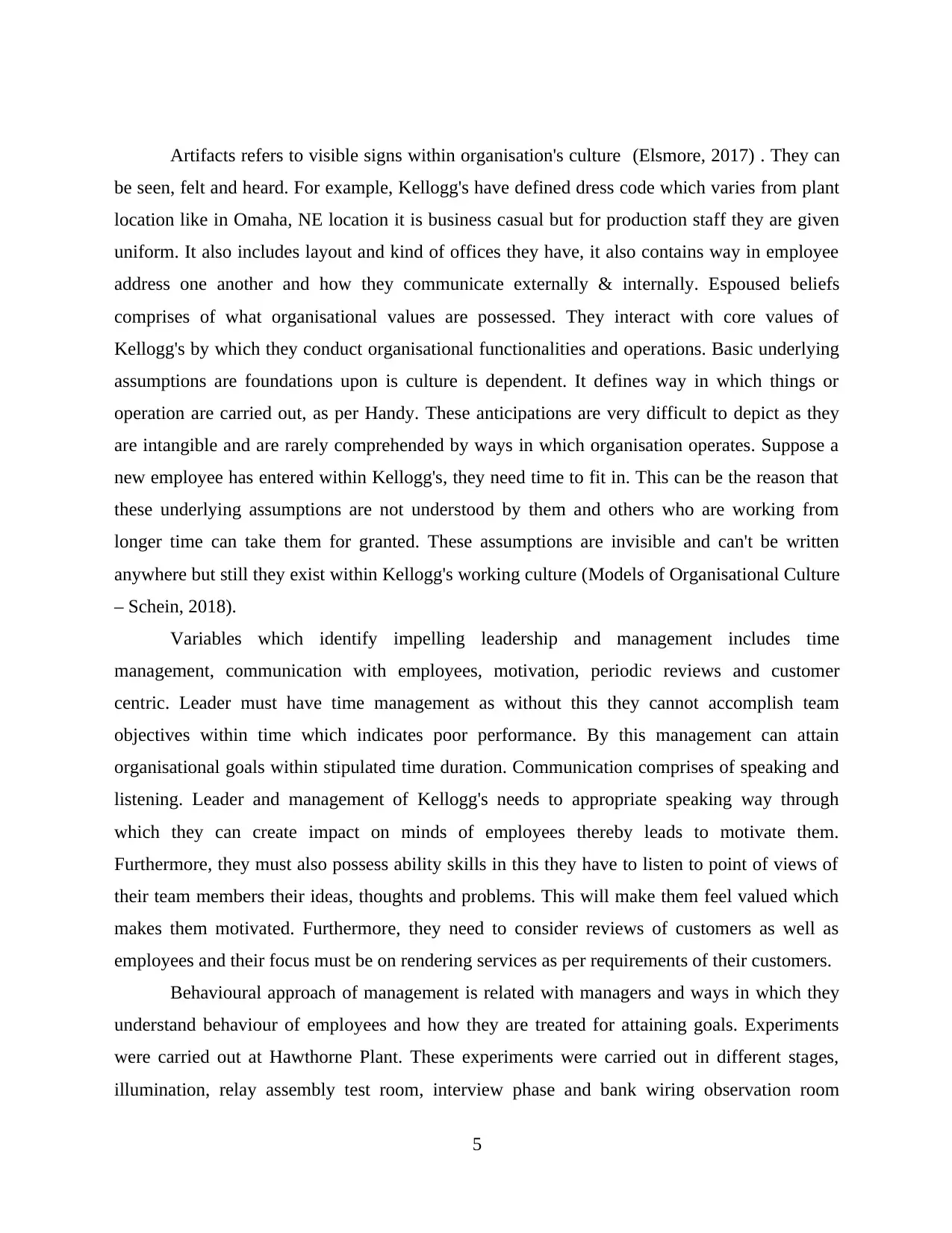
Artifacts refers to visible signs within organisation's culture (Elsmore, 2017) . They can
be seen, felt and heard. For example, Kellogg's have defined dress code which varies from plant
location like in Omaha, NE location it is business casual but for production staff they are given
uniform. It also includes layout and kind of offices they have, it also contains way in employee
address one another and how they communicate externally & internally. Espoused beliefs
comprises of what organisational values are possessed. They interact with core values of
Kellogg's by which they conduct organisational functionalities and operations. Basic underlying
assumptions are foundations upon is culture is dependent. It defines way in which things or
operation are carried out, as per Handy. These anticipations are very difficult to depict as they
are intangible and are rarely comprehended by ways in which organisation operates. Suppose a
new employee has entered within Kellogg's, they need time to fit in. This can be the reason that
these underlying assumptions are not understood by them and others who are working from
longer time can take them for granted. These assumptions are invisible and can't be written
anywhere but still they exist within Kellogg's working culture (Models of Organisational Culture
– Schein, 2018).
Variables which identify impelling leadership and management includes time
management, communication with employees, motivation, periodic reviews and customer
centric. Leader must have time management as without this they cannot accomplish team
objectives within time which indicates poor performance. By this management can attain
organisational goals within stipulated time duration. Communication comprises of speaking and
listening. Leader and management of Kellogg's needs to appropriate speaking way through
which they can create impact on minds of employees thereby leads to motivate them.
Furthermore, they must also possess ability skills in this they have to listen to point of views of
their team members their ideas, thoughts and problems. This will make them feel valued which
makes them motivated. Furthermore, they need to consider reviews of customers as well as
employees and their focus must be on rendering services as per requirements of their customers.
Behavioural approach of management is related with managers and ways in which they
understand behaviour of employees and how they are treated for attaining goals. Experiments
were carried out at Hawthorne Plant. These experiments were carried out in different stages,
illumination, relay assembly test room, interview phase and bank wiring observation room
5
be seen, felt and heard. For example, Kellogg's have defined dress code which varies from plant
location like in Omaha, NE location it is business casual but for production staff they are given
uniform. It also includes layout and kind of offices they have, it also contains way in employee
address one another and how they communicate externally & internally. Espoused beliefs
comprises of what organisational values are possessed. They interact with core values of
Kellogg's by which they conduct organisational functionalities and operations. Basic underlying
assumptions are foundations upon is culture is dependent. It defines way in which things or
operation are carried out, as per Handy. These anticipations are very difficult to depict as they
are intangible and are rarely comprehended by ways in which organisation operates. Suppose a
new employee has entered within Kellogg's, they need time to fit in. This can be the reason that
these underlying assumptions are not understood by them and others who are working from
longer time can take them for granted. These assumptions are invisible and can't be written
anywhere but still they exist within Kellogg's working culture (Models of Organisational Culture
– Schein, 2018).
Variables which identify impelling leadership and management includes time
management, communication with employees, motivation, periodic reviews and customer
centric. Leader must have time management as without this they cannot accomplish team
objectives within time which indicates poor performance. By this management can attain
organisational goals within stipulated time duration. Communication comprises of speaking and
listening. Leader and management of Kellogg's needs to appropriate speaking way through
which they can create impact on minds of employees thereby leads to motivate them.
Furthermore, they must also possess ability skills in this they have to listen to point of views of
their team members their ideas, thoughts and problems. This will make them feel valued which
makes them motivated. Furthermore, they need to consider reviews of customers as well as
employees and their focus must be on rendering services as per requirements of their customers.
Behavioural approach of management is related with managers and ways in which they
understand behaviour of employees and how they are treated for attaining goals. Experiments
were carried out at Hawthorne Plant. These experiments were carried out in different stages,
illumination, relay assembly test room, interview phase and bank wiring observation room
5
Paraphrase This Document
Need a fresh take? Get an instant paraphrase of this document with our AI Paraphraser
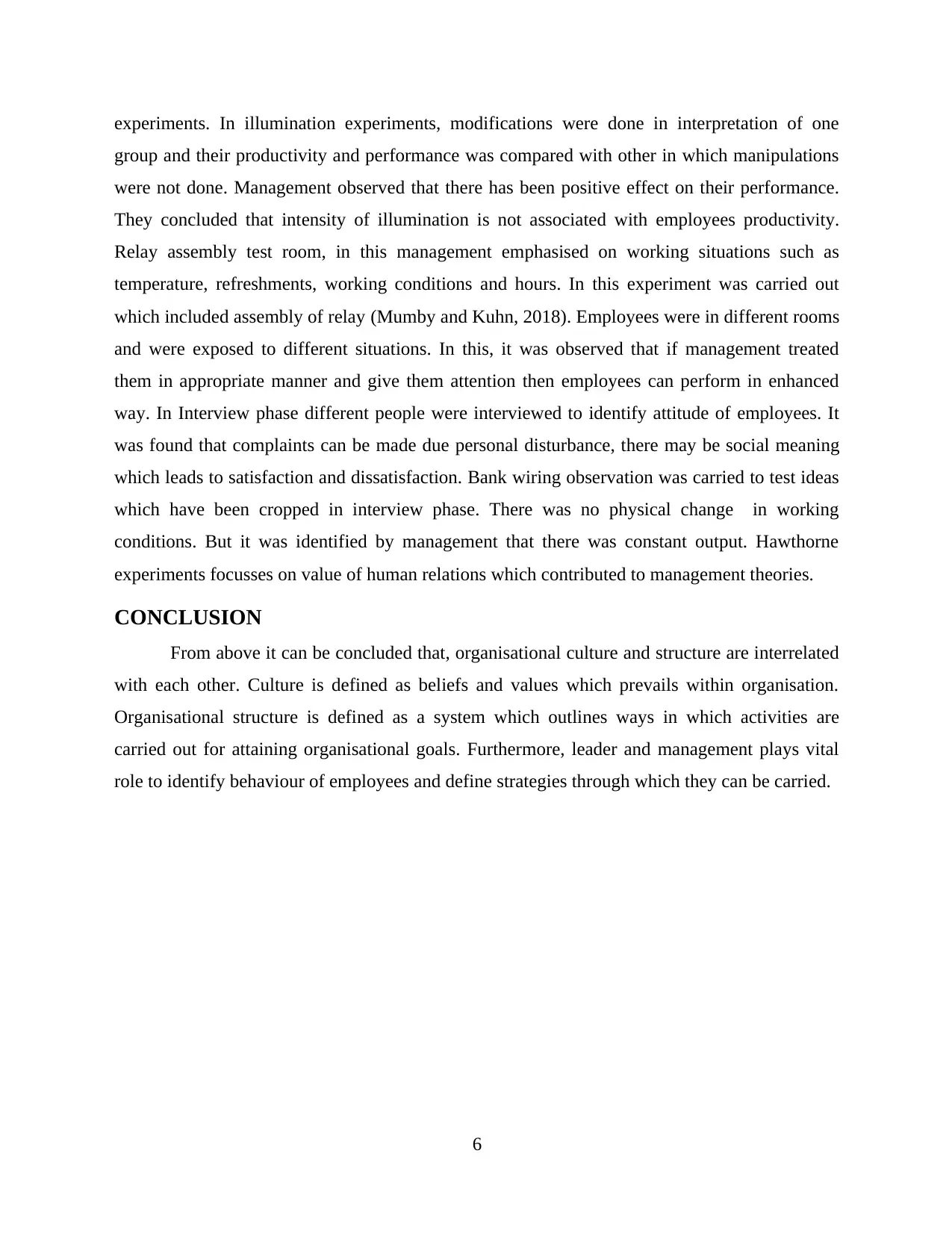
experiments. In illumination experiments, modifications were done in interpretation of one
group and their productivity and performance was compared with other in which manipulations
were not done. Management observed that there has been positive effect on their performance.
They concluded that intensity of illumination is not associated with employees productivity.
Relay assembly test room, in this management emphasised on working situations such as
temperature, refreshments, working conditions and hours. In this experiment was carried out
which included assembly of relay (Mumby and Kuhn, 2018). Employees were in different rooms
and were exposed to different situations. In this, it was observed that if management treated
them in appropriate manner and give them attention then employees can perform in enhanced
way. In Interview phase different people were interviewed to identify attitude of employees. It
was found that complaints can be made due personal disturbance, there may be social meaning
which leads to satisfaction and dissatisfaction. Bank wiring observation was carried to test ideas
which have been cropped in interview phase. There was no physical change in working
conditions. But it was identified by management that there was constant output. Hawthorne
experiments focusses on value of human relations which contributed to management theories.
CONCLUSION
From above it can be concluded that, organisational culture and structure are interrelated
with each other. Culture is defined as beliefs and values which prevails within organisation.
Organisational structure is defined as a system which outlines ways in which activities are
carried out for attaining organisational goals. Furthermore, leader and management plays vital
role to identify behaviour of employees and define strategies through which they can be carried.
6
group and their productivity and performance was compared with other in which manipulations
were not done. Management observed that there has been positive effect on their performance.
They concluded that intensity of illumination is not associated with employees productivity.
Relay assembly test room, in this management emphasised on working situations such as
temperature, refreshments, working conditions and hours. In this experiment was carried out
which included assembly of relay (Mumby and Kuhn, 2018). Employees were in different rooms
and were exposed to different situations. In this, it was observed that if management treated
them in appropriate manner and give them attention then employees can perform in enhanced
way. In Interview phase different people were interviewed to identify attitude of employees. It
was found that complaints can be made due personal disturbance, there may be social meaning
which leads to satisfaction and dissatisfaction. Bank wiring observation was carried to test ideas
which have been cropped in interview phase. There was no physical change in working
conditions. But it was identified by management that there was constant output. Hawthorne
experiments focusses on value of human relations which contributed to management theories.
CONCLUSION
From above it can be concluded that, organisational culture and structure are interrelated
with each other. Culture is defined as beliefs and values which prevails within organisation.
Organisational structure is defined as a system which outlines ways in which activities are
carried out for attaining organisational goals. Furthermore, leader and management plays vital
role to identify behaviour of employees and define strategies through which they can be carried.
6
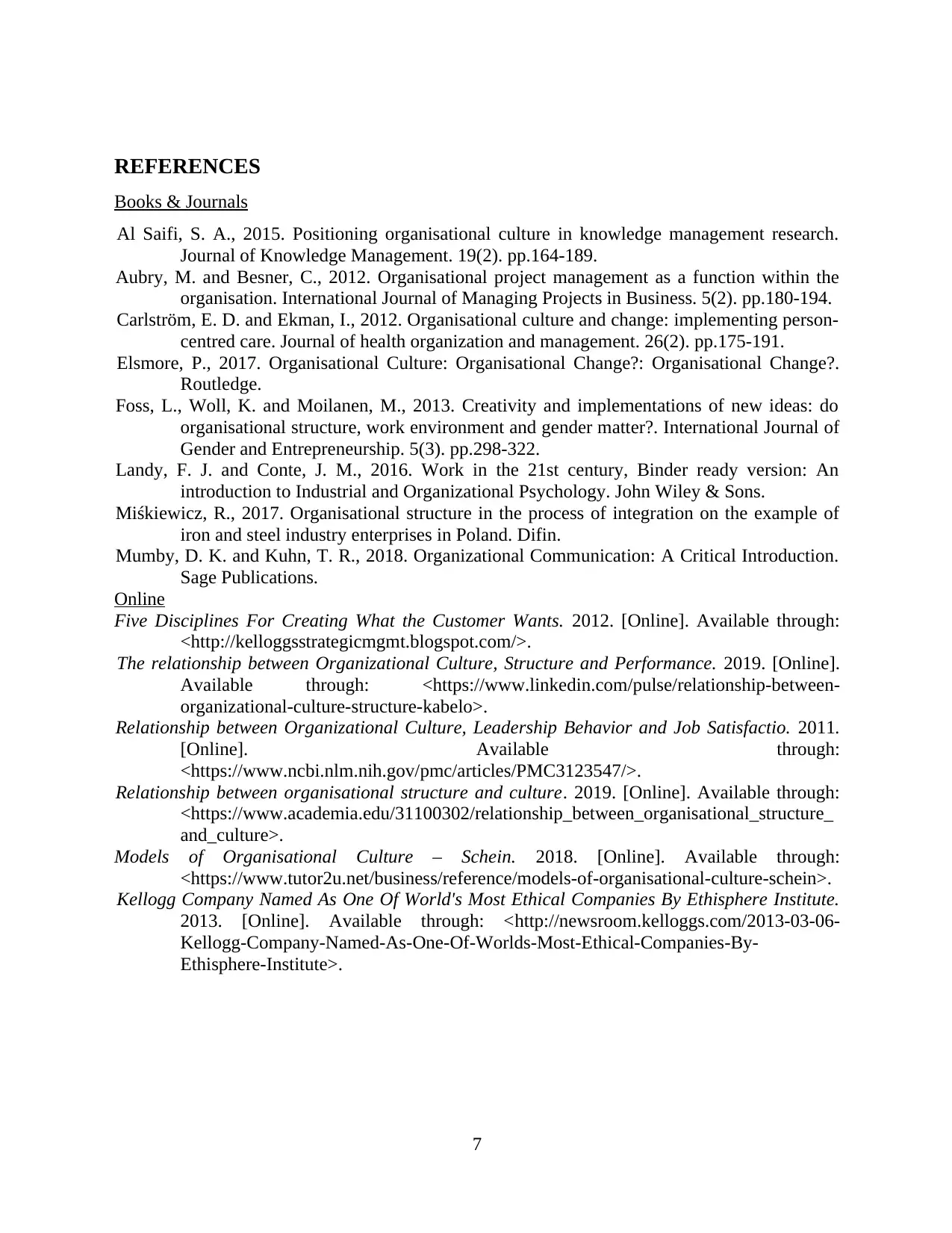
REFERENCES
Books & Journals
Al Saifi, S. A., 2015. Positioning organisational culture in knowledge management research.
Journal of Knowledge Management. 19(2). pp.164-189.
Aubry, M. and Besner, C., 2012. Organisational project management as a function within the
organisation. International Journal of Managing Projects in Business. 5(2). pp.180-194.
Carlström, E. D. and Ekman, I., 2012. Organisational culture and change: implementing person-
centred care. Journal of health organization and management. 26(2). pp.175-191.
Elsmore, P., 2017. Organisational Culture: Organisational Change?: Organisational Change?.
Routledge.
Foss, L., Woll, K. and Moilanen, M., 2013. Creativity and implementations of new ideas: do
organisational structure, work environment and gender matter?. International Journal of
Gender and Entrepreneurship. 5(3). pp.298-322.
Landy, F. J. and Conte, J. M., 2016. Work in the 21st century, Binder ready version: An
introduction to Industrial and Organizational Psychology. John Wiley & Sons.
Miśkiewicz, R., 2017. Organisational structure in the process of integration on the example of
iron and steel industry enterprises in Poland. Difin.
Mumby, D. K. and Kuhn, T. R., 2018. Organizational Communication: A Critical Introduction.
Sage Publications.
Online
Five Disciplines For Creating What the Customer Wants. 2012. [Online]. Available through:
<http://kelloggsstrategicmgmt.blogspot.com/>.
The relationship between Organizational Culture, Structure and Performance. 2019. [Online].
Available through: <https://www.linkedin.com/pulse/relationship-between-
organizational-culture-structure-kabelo>.
Relationship between Organizational Culture, Leadership Behavior and Job Satisfactio. 2011.
[Online]. Available through:
<https://www.ncbi.nlm.nih.gov/pmc/articles/PMC3123547/>.
Relationship between organisational structure and culture. 2019. [Online]. Available through:
<https://www.academia.edu/31100302/relationship_between_organisational_structure_
and_culture>.
Models of Organisational Culture – Schein. 2018. [Online]. Available through:
<https://www.tutor2u.net/business/reference/models-of-organisational-culture-schein>.
Kellogg Company Named As One Of World's Most Ethical Companies By Ethisphere Institute.
2013. [Online]. Available through: <http://newsroom.kelloggs.com/2013-03-06-
Kellogg-Company-Named-As-One-Of-Worlds-Most-Ethical-Companies-By-
Ethisphere-Institute>.
7
Books & Journals
Al Saifi, S. A., 2015. Positioning organisational culture in knowledge management research.
Journal of Knowledge Management. 19(2). pp.164-189.
Aubry, M. and Besner, C., 2012. Organisational project management as a function within the
organisation. International Journal of Managing Projects in Business. 5(2). pp.180-194.
Carlström, E. D. and Ekman, I., 2012. Organisational culture and change: implementing person-
centred care. Journal of health organization and management. 26(2). pp.175-191.
Elsmore, P., 2017. Organisational Culture: Organisational Change?: Organisational Change?.
Routledge.
Foss, L., Woll, K. and Moilanen, M., 2013. Creativity and implementations of new ideas: do
organisational structure, work environment and gender matter?. International Journal of
Gender and Entrepreneurship. 5(3). pp.298-322.
Landy, F. J. and Conte, J. M., 2016. Work in the 21st century, Binder ready version: An
introduction to Industrial and Organizational Psychology. John Wiley & Sons.
Miśkiewicz, R., 2017. Organisational structure in the process of integration on the example of
iron and steel industry enterprises in Poland. Difin.
Mumby, D. K. and Kuhn, T. R., 2018. Organizational Communication: A Critical Introduction.
Sage Publications.
Online
Five Disciplines For Creating What the Customer Wants. 2012. [Online]. Available through:
<http://kelloggsstrategicmgmt.blogspot.com/>.
The relationship between Organizational Culture, Structure and Performance. 2019. [Online].
Available through: <https://www.linkedin.com/pulse/relationship-between-
organizational-culture-structure-kabelo>.
Relationship between Organizational Culture, Leadership Behavior and Job Satisfactio. 2011.
[Online]. Available through:
<https://www.ncbi.nlm.nih.gov/pmc/articles/PMC3123547/>.
Relationship between organisational structure and culture. 2019. [Online]. Available through:
<https://www.academia.edu/31100302/relationship_between_organisational_structure_
and_culture>.
Models of Organisational Culture – Schein. 2018. [Online]. Available through:
<https://www.tutor2u.net/business/reference/models-of-organisational-culture-schein>.
Kellogg Company Named As One Of World's Most Ethical Companies By Ethisphere Institute.
2013. [Online]. Available through: <http://newsroom.kelloggs.com/2013-03-06-
Kellogg-Company-Named-As-One-Of-Worlds-Most-Ethical-Companies-By-
Ethisphere-Institute>.
7
⊘ This is a preview!⊘
Do you want full access?
Subscribe today to unlock all pages.

Trusted by 1+ million students worldwide
1 out of 9
Related Documents
Your All-in-One AI-Powered Toolkit for Academic Success.
+13062052269
info@desklib.com
Available 24*7 on WhatsApp / Email
![[object Object]](/_next/static/media/star-bottom.7253800d.svg)
Unlock your academic potential
Copyright © 2020–2025 A2Z Services. All Rights Reserved. Developed and managed by ZUCOL.





